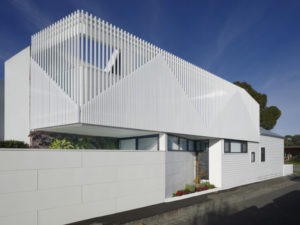Project Description
Bourne Lane House is a contemporary eco-home that sits harmoniously in the grounds of a traditional nineteenth-century oast house that has been the client’s home for 25 years. Conceived for a Norwegian and British couple contemplating retirement and no longer wishing to look after such a large, high-maintenance property, this new, low-rise home has been designed to be modern, sustainable, accessible and flexible. Ensuring it will continue to serve their needs for as long as necessary, it is intimate enough for two, yet adaptable for large family occasions and visiting grandchildren.
“The oast house was perfect for large family gatherings. When we decided to downsize, one of our biggest concerns was to still have the flexibility to allow all the family to visit at once” – client.
The low-rise structure was developed around two asymmetric barn-like wings, connected by a central entrance hall that draws guests into the house with extensive views onto the garden beyond. Dividing the two elements into distinct living and sleeping quarters, this central space serves as the main entrance to the house, as well as a flexible dining space for large family get-togethers and parties. The intimate sheltered courtyard beyond is perfectly positioned to benefit from the evening light. All spaces and views towards and from the property have been positioned for maximum light and privacy, responding to natural sun patterns, as well as the clients’ brief to create quieter sanctuaries away from the social areas of the house. The distinctive eaves that lower towards the neighbouring boundaries and the green sedum roof allow the elements of the building to blend further into the environment.“The form of the building is to a large extent a response to the client’s requirement for natural light andviews out” – Simon Baker.
The open plan kitchen and living room, with its dramatic double height space projecting onto the terrace and garden, is accessed through a folding partition. Flooded with natural light at all times of the day, this space was conceived for the family to relax and entertain around the wood-burning fire. A mezzanine area functions as a study, accessed from a timber staircase and with fine views over the living area and into the garden beyond. Behind this lies a further space suitable for quiet work or for use as an occasional grandchildren’s bedroom. Contained within the partially submerged lower ground floor below there are a cosy TV area, utility room, and WC, with specially orientated external wooden louvres providing shade for these spaces during the summer months. The second wing, accessed through sliding doors from the entrance/dining area, has been designed as a more intimate and quiet sleeping area, with two bedrooms and bathrooms – both of which are accessible to the disabled.
The property has been designed to meet the standards of both the Code for Sustainable Homes (level 4) and Lifetime Homes. It was built using cross-laminated timber panels (CLT) and the interior is a celebration of wood as a structural and visual material. Both the Douglas fir flooring and the exposed CLT ceilings have been treated with lime to lighten their finishes and prevent the wood from yellowing over time. The off-white walls help to balance the use of timber and provide a suitable backdrop for the owners’ eclectic art and furniture.






























